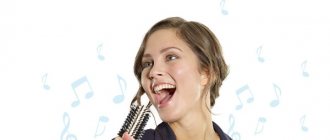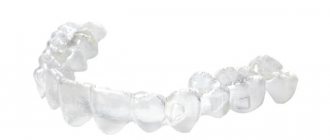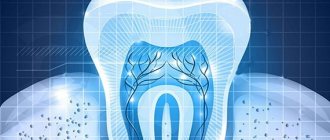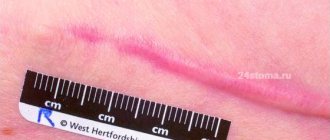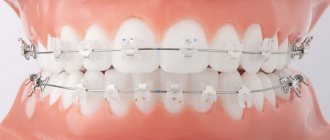The best time to correct your bite with braces is adolescence. But children during puberty are very sensitive to the opinions of others, their self-esteem is often reduced. Metal braces on teeth can become an additional reason for complexes. Multi-colored braces will help solve the problem.
In this article
- What are the design features of colored braces?
- Why do you need colored rubber bands for braces?
- Braces with colored rubber bands - what are they?
- What colors are braces?
- What to consider when choosing the color of braces?
- How are colored braces installed?
- Why is it necessary to replace colored ligatures?
Ligature braces - what are they?
This is an orthodontic design in which there is a metal bracket (arc) connected to braces-locks on the teeth. The bracket is threaded through the groove of each lock, combining them into a single system. Each lock in the ligature bracket system is attached to the arch with ligatures. They can be in the form of rubber or wire rings. The structure is installed so that the bracket determines the vector of movement of the dentition units. For adult patients, clear or white elastic bands are used. Multi-colored rubber bands will suit your child as an additional decoration.
Despite the fact that today more advanced types of braces with self-regulating elements are being produced, the classic ligature version is still popular because of its reliability. In addition, this is a less expensive correction option.
The history of bite correction goes back many centuries. The first prototype of modern types of braces appeared only in the 17th century in France: the court dentist Pierre Fauchard straightened teeth using a plate tightly tied to the dentition with strong threads. Many specialists tried to contribute to the creation of the desired design, but only at the end of the 19th century a real breakthrough occurred: the American dentist Engle created a device based on the force of an arc. Since then, the design created by Engle has been constantly improved.
Alternative to colored rubber bands
Doctors often camouflage the metal archwire by using colored wire to help make the staples themselves attractive. The wire can be created from steel or silver, titanium or aluminum. It is more wear-resistant and lasts longer compared to ligatures. However, it has one significant drawback - under the influence of drinks and food consumed, temperature changes, its outer layer can crack, which will look unaesthetic. Therefore, orthodontists still often advise choosing braces with ligatures.
Who is suitable for ligature braces?
When carrying out treatment, the orthodontist conducts a preliminary examination of the patient, after which he analyzes the data obtained and decides on the possibility of installing braces.
Installation of ligature braces is indicated for:
- various malocclusions;
- crowding and curvature of units of the dental system;
- the presence of large gaps between teeth – diastema and three;
- impacted or unerupted teeth due to lack of space – promotes the movement of teeth and their normal eruption;
- violation of the facial contour due to various anomalies of the dental system;
- atrophy of the jaw bone and reduction of interdental spaces in preparation for prosthetics or implantation.
Contraindications are divided into absolute and relative. The absolute ones include:
- severe osteoporosis - fragility of bones due to the loss of bone tissue minerals, especially calcium;
- decompensated (with unstable blood sugar) diabetes mellitus;
- congenital and acquired (AIDS) immunodeficiencies;
- bone tuberculosis;
- edentia – toothless jaw;
- bruxism;
- oncological processes after radiation or chemotherapy;
- severe psychoses.
Relative (eliminable) contraindications:
- chronic periodontitis and periodontal disease in the acute stage;
- caries and its complications;
- any acute and exacerbation of chronic pathological processes.
Bottom line
Colored braces are not only a high-quality and quick correction of dental deformations and malocclusions, but also the elimination of psychological discomfort in a teenager. Thanks to the ability to choose unusual color schemes, teenagers agree to such manipulations and quickly acquire healthy teeth.
Sources
- https://CreateSmile.ru/color-braces/
- https://jsmiles.ru/ortodontiya/8-brekety/103-cvetnye/
- https://orto-info.ru/sistemyi-vyiravnivaniya-zubov/breketyi/po-tipu-materiala/tsvetnyie.html
- https://anZub.ru/lechenie-prikusa/cvetnye-brekety/
- https://breketov.net/tsvetnye-brekety-luchshij-vybor-dlya-detej
- https://mnogozubov.ru/cvetnye-brekety/
- https://MikDent.ru/ortodont/breketi/cvetnye-brekety.html
- https://32zuba.guru/brekety/vidi/tsvetnie/
- https://FB.ru/article/395016/tsvetnyie-breketyi-opisanie-i-vidyi-pokazaniya-i-protivopokazaniya-foto-i-otzyivyi
- https://zub.clinic/brekety/tsvetnye
- https://youstom.com/ortodontiya/brekety/cvetnye-brekety-dlya-detej.html
Pros and cons of ligature braces
Advantages:
- correction of anomalies of the dental system of increased complexity: ligatures give the system additional strength and reliability;
- the ability to change the types of ligatures according to the patient’s choice; colored ones are especially suitable for children, white and colorless – for adults; rubber ligatures can be replaced with wire ones;
- the possibility of frequent monitoring of the treatment process with changes in specified parameters;
- reasonable price and wide selection of prices.
Flaws:
- lengthy process of installing ligature braces;
- the system is bulky and noticeable on the teeth;
- transparent and colorless ligatures quickly turn yellow from food coloring and take on an unaesthetic appearance;
- the need for monthly visits to the orthodontist to monitor and correct treatment;
- frequent complaints from patients about irritation of the oral mucosa with ligatures, which helps to lengthen the period of adaptation to the system; after changing the ligatures, the patient may feel pain for some time;
- it is more difficult to carry out hygiene procedures.
Color selection
When choosing the appropriate shade, you should take the advice of orthodontists. Often patients seek to install snow-white braces, but this is not recommended. Even the whitest teeth will appear yellowish against the background of this design. You can choose a tone to match your eye or skin color - it looks beautiful. It is important not to forget that contrasting shades visually brighten teeth, while powdered shades make them darker.
The choice of yellow color must be approached with great care; certain tones of it give yellowness to the enamel. If you really like this color, it is better to choose a contrasting shade; it will visually make your teeth brighter. If the enamel is naturally grayish, spring tones will harmonize with it. On dark teeth, black, burgundy, and dark blue look best. You can focus on your own originality through orange, red, green braces that will suit everyone.
Representatives of the fair sex often choose delicate tones. The most popular colors are blue, turquoise and light green. Pink is also considered a purely feminine color. Models in the shape of a heart or a flower look interesting. Guys prefer a calmer color and tend to choose discreet solutions. For example, dark versions of purple, green, and blue look good. As for children, they will be glad to have braces in rainbow colors, because kids love everything bright and colorful.
In VIP dental clinics, such installations are divided into groups: for boys, girls, men and women. Each can have more than 10 color schemes, including warm and cold shades. Most braces allow you to regularly change ligatures and elastic bands. This gives you the opportunity to endlessly experiment with your own appearance.
Types of models with ligatures
Designs from different manufacturers may differ in material of manufacture and location of attachment.
Braces made of various materials
Below are comparative characteristics of various models.
Metal ligature braces
Braces made of metal alloys
The main advantage of metal braces is that they are suitable for correcting bites of any complexity. They are reliable, but bulky and not very attractive in appearance, which is why they are preferred for children. World leaders in the production of such systems are trying to smooth out the shortcomings by releasing smaller models with a light Teflon coating and, accordingly, with a higher price.
- Pros: durability, high therapeutic effect and low price.
- Disadvantages: irritation of the oral mucosa, pain during the adaptation period, unaesthetic, cheap models containing nickel may cause allergies.
Ceramic ligature braces
Ceramic braces
Ceramics are very similar in appearance to tooth enamel. It does not produce glitter and blends with natural crowns, creating an invisibility effect. Dental ceramics are a very durable, but rather fragile material. Ceramic braces do not injure the mucous membranes, so the adaptation period is quick and easy.
- Pros: look beautiful, minimal risk of injury, lightweight, comfortable, biocompatible.
- Cons: less reliable than metal ones, can break and be stained with dyes, have a higher price.
Sapphire ligature braces
Sapphire braces
Made from artificial sapphires. They are transparent, shimmer and look very beautiful. Sapphire braces are not suitable for correcting all defects: their low strength lets them down.
- Pros: aesthetics, no staining, hypoallergenic, short adaptation period.
- Disadvantages: low strength and reliability, in the absence of high-quality hygiene, clouding is possible, high cost. Due to fragility, not suitable for children. Read here which system is best for your child.
Plastic
Plastic transparent braces
These are visually very attractive systems made of medical plastic with hypoallergenic properties. They are white in color, invisible on the teeth, but are not highly reliable, so they cannot be used to correct serious defects in the dental system. Prices vary depending on the quality of the product and the manufacturing company.
- Pros: aesthetics, complete biocompatibility, lightness and ease of wearing.
- Cons: fragility, frequent breakdowns, dark colors, especially when smoking.
Combined
Combined (ceramics on the front, metal on the sides) braces
To increase functionality and aesthetics, and reduce cost, combined structures are installed. To do this, locks made of ceramics, sapphires or plastic are installed on the front, and metal on the sides.
At the location of attachment
Based on this feature, structures are divided into two types - vestibular and lingual. There are significant differences in the installation features of these models.
Vestibular and lingual models
Vestibular type structures
These braces are considered classics. They are attached to the sides of dental crowns facing the inner surface of the lips and cheeks. Such structures are easier to install, they cause less trauma to the mucous membrane and almost do not cause problems with diction during the adaptation period. Metal models of this type can be used to eliminate serious defects.
- Pros: stability, ease of installation, treatment time is shorter than with lingual ones.
- Cons: unaesthetic.
Lingual braces
These are more modern designs. The difference is that lingual braces are attached to the inner, tongue-facing side of the dental crowns. Outwardly they are invisible, but less convenient to wear and install. They have a fairly long adaptation period, as they often injure the tongue and affect the clarity of speech.
- Pros: invisible when smiling, wearing them does not cause psychological discomfort.
- Disadvantages: they often cause pain, discomfort and speech impairment, it is impossible to treat serious disorders, they are much more expensive than vestibular ones.
Main features and purpose of color systems
Colored braces, as in the photo, differ from ordinary classic ones in that they almost completely cover and disguise the metal arches, and only the locking parts of the system remain open. This feature allows young patients to feel more confident and free from psychological discomfort. Such devices look like a decorative element on the teeth and allow you to create an individual image that will be the envy of other teenagers, which is very important for a child undergoing quite complex orthodontic treatment.
Important! Regardless of what material the braces are made from, they all have a metal arch. The arch itself can also be painted white for aesthetics, but it is important to remember that the top paint may peel off during use due to friction that occurs when the teeth move in a given direction. This factor may slightly increase the treatment time, which is why many patients prefer to leave the metal arch unpainted.
Otherwise, colored braces for children are no different from other models; they have an orthodontic arch that is located above the teeth and moves them in a given direction. They also allow you to correct and correct malocclusions of any complexity.
Popular brands of ligature braces
Brand systems Alexander, Clarity
Global manufacturers are releasing more and more new lines of brands that have differences in design. The most famous and popular brands:
Alexander (Ormco, USA) – metal ligature bracket system made of high-quality steel; a very popular model with narrow locks; the design is effective in treating any anomalies, comfortable to wear: the adaptation period is quick and painless; the price is high.
Clarity Advanced (American company 3M Unitek) - made of high-quality durable ceramics; the locks are small and do not create problems during the adaptation period; patients are always satisfied with the aesthetic appearance of the structure; average price category.
Brand Inspire ICE
Inspire ICE (Ormco, USA) – a very beautiful, transparent model that shimmers when illuminated; durable, but also fragile, like all sapphire structures; The disadvantages are increased fragility and high price.
Radiance (American Orthodontics, USA) - made of translucent sapphires, almost indistinguishable in color from tooth enamel, therefore completely invisible when smiling; expensive models.
Pumo (Ortho Technology, USA) – made of sapphires treated with zirconium, which gives the model additional strength; the cost is lower than previous models.
Spirit MB (American company Ormco) - models made of plastic on a metal base; light, beautiful, comfortable; the disadvantages are a possible change in color and insufficient strength, and therefore the design is used to eliminate simple defects; quite expensive, but the best model in its segment.
Plastic braces from Ortolite, Russia are of lower quality than the previous ones, but they are light, beautiful and inexpensive models.
Advantages
Colored braces are safe to use and are not inferior in effectiveness to the classic options.
In addition, the original design has a number of other advantages :
- Wearing the system not only promotes physical improvements, but also provides psychological comfort .
This makes it indispensable for correcting occlusion in children who react sharply to changes in their appearance in a direction that is unfavorable to them. The main point here will be the child’s independent choice of the required color scheme; - ligatures are made from hypoallergenic material, and therefore they are absolutely safe for use ;
- On colored structures the effects of use are less noticeable. Ligatures retain their shade well and do not stain , even after regular use of coloring products;
- on bright surfaces, food residues or plaque are not so noticeable , which cannot always be removed in a timely manner;
- Despite the originality of design, such devices do not differ in cost from installing a classic design.
Also, the benefits include the positive emotions that children experience when using them. Thanks to this, getting used to the system becomes faster and less painful.
Installation of ligature braces
Installation is carried out in stages:
The first stage is diagnosis. The patient is prescribed laboratory and instrumental tests: general and biochemical blood tests, blood clotting tests, plain radiography of the jaw, computed tomography (CT). The patient is also sent for a consultation with a dental therapist.
The second stage is sanitation of the oral cavity in case of detection of pathology. Treatment of caries and its complications, gum diseases, etc. is carried out. After this, the dentist performs professional oral hygiene, removes soft and hard plaque, and polishes the enamel. The orthodontist analyzes the data obtained and makes a decision on installing a certain type of braces.
The third stage is installation. The doctor cleans, dries the dental crowns and places braces on them using a cement composition in two ways:
- by gluing each lock individually to the crown - this takes quite a lot of time, but provides the most accurate correction (direct method);
- creating a special silicone mold with installed clasps, and then transferring them to the teeth - installation is faster and easier when compared with the previous option (indirect method).
The cement is dried with a special lamp, the remaining cement is removed and a metal arch is installed, threading it through the grooves of the braces. Then the bracket is further strengthened with soft elastic or hard wire rings (ligatures). On the sides, the braces are secured with fixing rings on the molars. The third stage takes about 60 minutes.
The bracket begins to exert force on the units, moving them in accordance with the set parameters. As the movement progresses, the force decreases, so the patient must come to the doctor's office monthly to activate the system.
Read more about the process of correction and adaptation here.
Which braces are better: ligature or non-ligature?
Non-ligating or self-ligating designs are also popular today. In these products, the bracket is attached to the clasps without the use of ligatures, using micro-clasps that tightly cover and hold the power arc in the grooves. Micro-locks can have an active influence on the process, maintaining pressure in the desired direction - these are active non-ligature models. More modern passive designs simply fix the staples, providing a gentle, physiological effect.
Ligature and non-ligature braces have their advantages and disadvantages. Many models provide a wide choice of braces for each patient. But the question of which braces are better, ligature or non-ligature, will be better answered by the attending physician, taking into account the individual characteristics and age of each patient. Adults often choose self-ligating models, but if the defect is highly complex, the orthodontist may recommend a ligature model.
Unlike adults, ligature models are more suitable for children and adolescents: they are more reliable, and frequent activation guarantees positive correction results. In addition, children often like multi-colored rubber bands on installed structures.
For comparison, here is a table that shows the difference between self-ligating and ligature braces, their similarities and differences:
| Key Features | Ligature construction | Self-ligating design |
| Fixing the system | Ligatures | Lids with locks |
| Material of manufacture | Metal, ceramics, sapphire, plastic | Metal, ceramics, sapphire |
| How often does the system need to be activated? | Once a month | Every 2 – 3 months |
| Discomfort and pain during the adaptation period | Depends on the individual characteristics of the patient | Depends on the individual characteristics of the patient |
| Duration of wearing the structure | From one year to 3 or more years | Shorter by a quarter or a third of the term depending on the manufacturing company |
| The effectiveness of corrective treatment | Possibility of correction of complex defects | Self-ligation is not suitable for the correction of the most complex defects |
| Is tooth extraction required before installing braces? | For small jaws and crowded teeth - a must | For small jaws and crowded teeth - a must |
| Cost of braces | 9 thousand rubles. and more | 25 thousand rubles. and more |
How much do ligature braces cost?
If we compare the cost of treatment, it depends on:
- diagnostic studies performed;
- the need and scope of oral sanitation;
- chosen design – material of manufacture, manufacturer;
- the orthodontist’s work on installation, activation and removal of the structure.
For comparison: the cost of installing the domestic metal model Pilot on one jaw is from 9 thousand rubles, and the metal model Alexander (USA) is from 14 thousand rubles. Ceramic models are more expensive - Clarity (USA) - from 40 thousand rubles, sapphire Inspire Ice - from 35 thousand rubles. Bracket systems made of high-quality plastic are also not cheap: installation by Spirit (USA) will cost from 26 thousand rubles.
Manufacturers
According to customer reviews, the following product brands are the best:
- Victory. The American leveling design includes multi-colored ligatures. It perfectly follows the contours of the teeth, so nothing will puff up. Getting used to it happens quickly. The plates are small in size, which will not interfere with eating or spoil speech.
- Ormco. A US company produces orthodontic systems made of titanium and steel. Colored structures have high strength ligatures.
- American Orthodontics. The company produces braces that are small in size and comfortable in shape.

